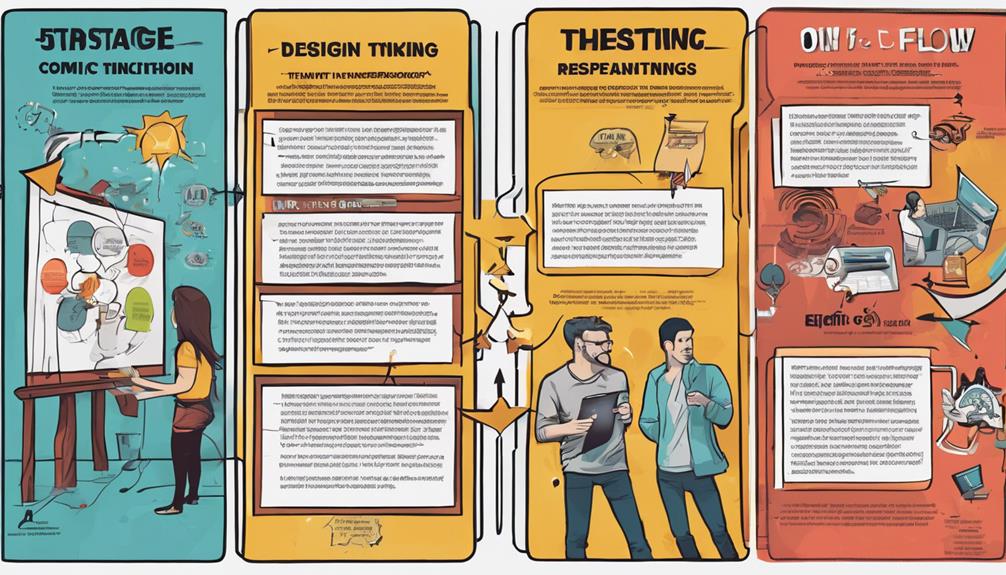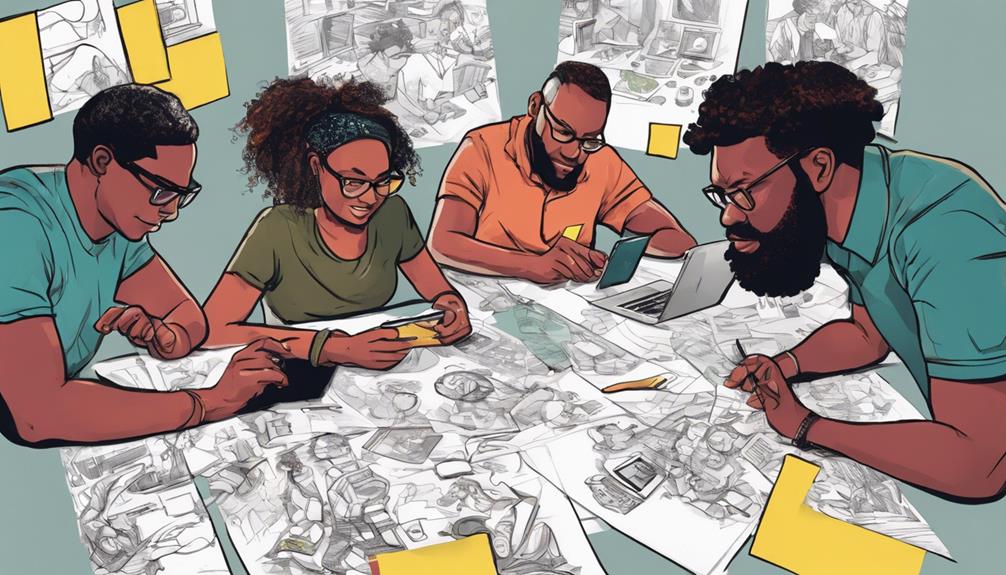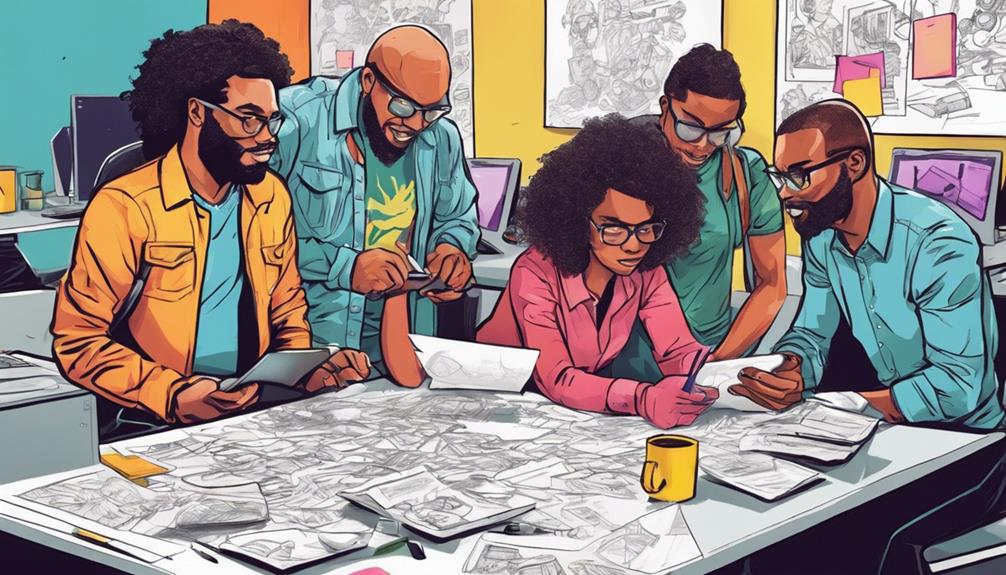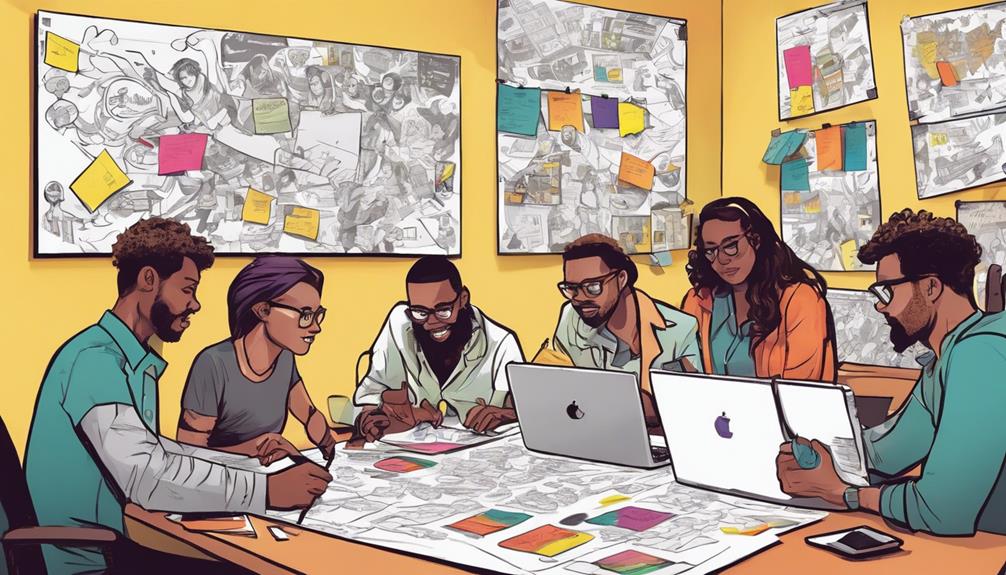Using a five-minute empathy map in your stakeholder meetings helps you quickly uncover their needs, motivations, and concerns. By focusing on their perspectives, you build trust and facilitate more effective communication. This simple tool allows you to tailor your approach, foster genuine relationships, and reduce misunderstandings. Incorporating these insights into your routine leads to stronger collaboration and better outcomes. If you want to discover how to master this powerful approach, keep going to learn more.
Key Takeaways
- Quickly define stakeholder personas focusing on needs, goals, and pain points to guide empathetic engagement.
- Use brief, open-ended questions and active listening to gather rapid insights into stakeholder perspectives.
- Visualize thoughts, feelings, and motivations on an empathy map to organize stakeholder data clearly.
- Incorporate feedback loops by reviewing the map regularly, refining understanding based on stakeholder responses.
- Integrate empathy exercises into meetings to foster trust, reduce misunderstandings, and tailor collaborative solutions effectively.
Understanding the Power of Empathy in Stakeholder Engagement

Understanding the power of empathy in stakeholder engagement is essential because it helps you build trust and foster meaningful relationships. By applying empathy techniques, you can better interpret stakeholder psychology—understanding their motivations, concerns, and expectations. Recognizing what drives their opinions allows you to tailor your communication effectively. When you genuinely demonstrate empathy, stakeholders feel valued and understood, which encourages openness and collaboration. This approach doesn’t just improve interactions; it creates a foundation of trust that can withstand challenges. Being aware of emotional responses and how they influence stakeholder decisions can further enhance your ability to connect authentically. Ultimately, understanding stakeholder psychology through empathy techniques enables you to anticipate needs, resolve conflicts more smoothly, and develop solutions that resonate with all parties involved. This empathetic approach transforms stakeholder engagement into a productive, mutually beneficial process.
Step-by-Step Guide to Creating a Five-Minute Empathy Map
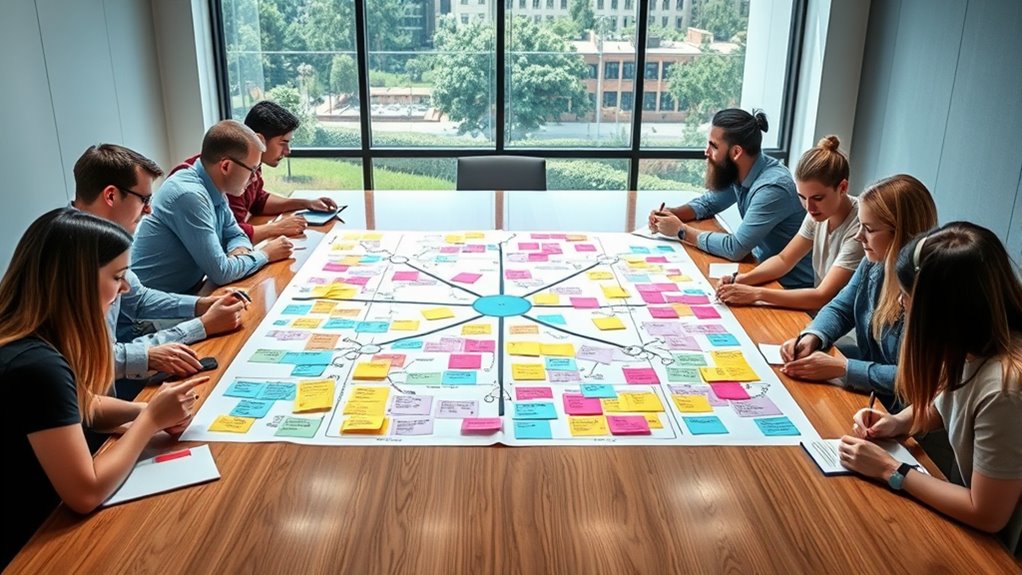
Creating an empathy map quickly and effectively can considerably enhance your stakeholder engagement process. Start by defining your stakeholder’s persona, focusing on their needs, goals, and pain points. Use persona mapping to organize this information clearly. Next, gather immediate insights through quick interviews or observations, then note their thoughts, feelings, and motivations on the map. Keep it simple and focus on key aspects. To guarantee your map remains relevant, incorporate feedback loops—review and refine the map based on stakeholder responses. This iterative process helps you better understand their perspective and adapt your approach in real time. Understanding the contrast ratio of your communication style can also improve engagement. With a structured, five-minute process, you can develop a clear, actionable empathy map that drives meaningful stakeholder conversations.
Practical Tips for Facilitating Rapid Stakeholder Insights
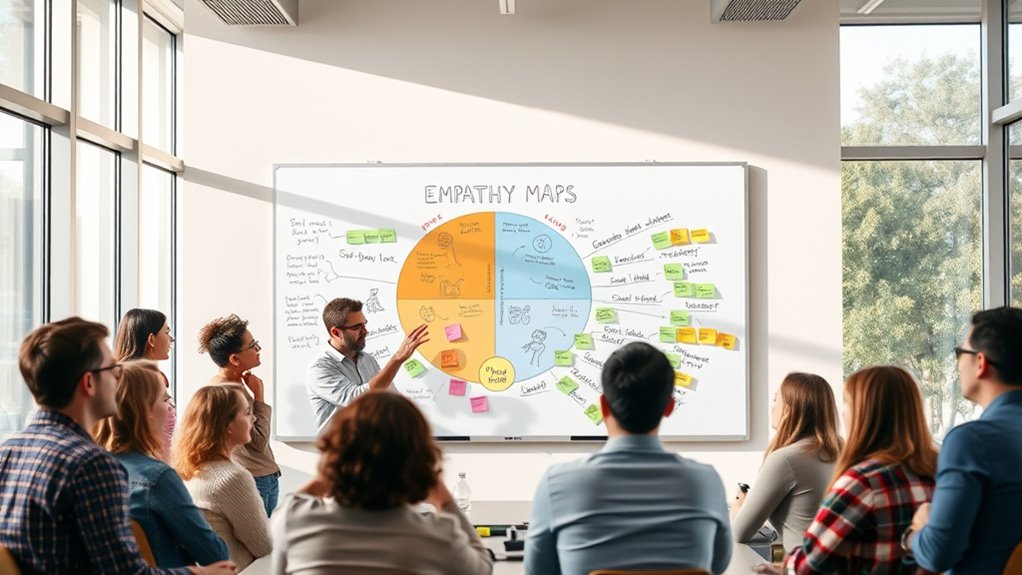
To gather rapid stakeholder insights effectively, focus on employing practical techniques that streamline your engagement process. Use empathy techniques like quick, open-ended questions to explore stakeholder perspectives deeply, helping you tap into stakeholder psychology. Keep the conversation focused by setting clear objectives and limiting the scope to what’s most relevant. Pay attention to non-verbal cues, as body language often reveals unspoken concerns or motivations. Encourage active listening, confirming your understanding to build trust and uncover genuine insights quickly. Use visual aids or simple prompts to guide discussions efficiently. Remember, the goal is to foster an environment where stakeholders feel heard and understood without overcomplicating the process. For example, understanding the importance of cookie consent management can help create a trustworthy environment that respects user preferences. These tips help you gain meaningful insights fast, making your meetings more productive.
Real-World Examples of Empathy Maps Enhancing Meetings
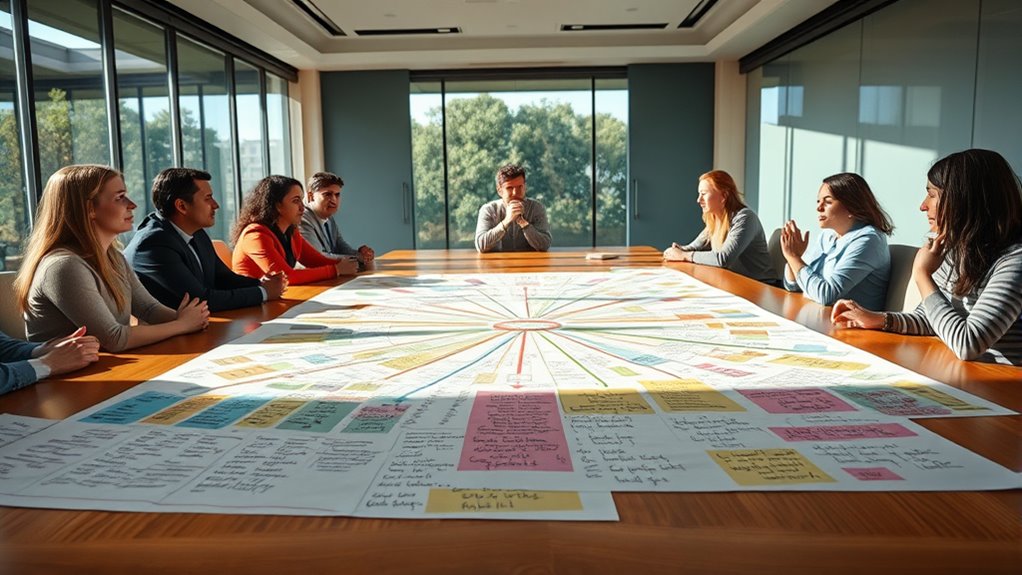
Real-world examples demonstrate how empathy maps can transform stakeholder meetings by providing clear insights into participants’ needs and motivations. For instance, teams often use empathy exercises to develop detailed stakeholder personas, which reveal underlying concerns and priorities. In one case, a product team conducted quick empathy exercises before discussions, helping them tailor solutions to specific stakeholder groups. This approach fostered trust and reduced misunderstandings during meetings. By visualizing stakeholder personas, teams better understand diverse perspectives, leading to more targeted and effective collaboration. Incorporating empathy exercises and stakeholder personas creates a more focused, insightful, and productive stakeholder dialogue.
Integrating the Empathy Map Into Your Meeting Routine
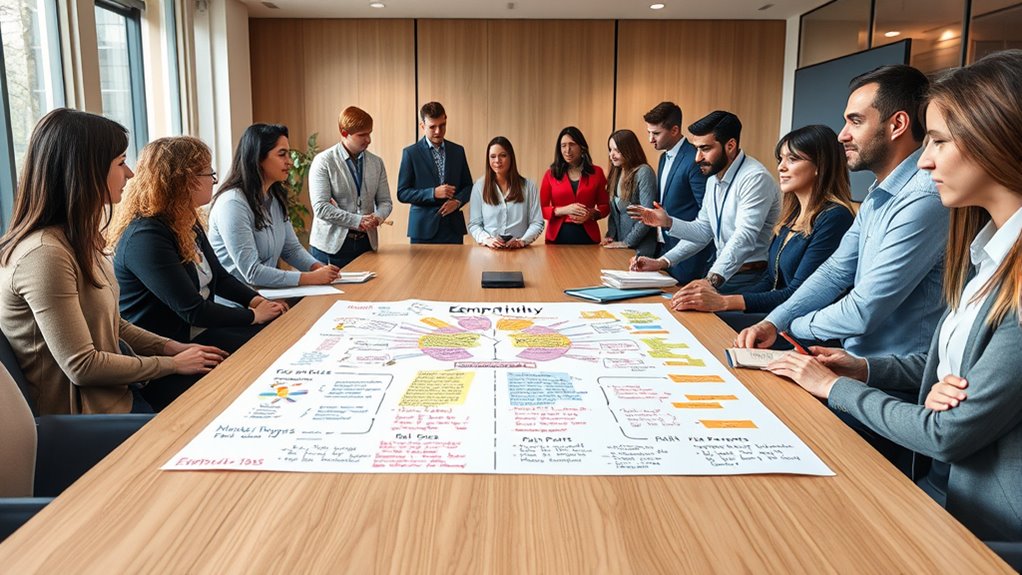
Integrating the empathy map into your meeting routine can considerably enhance how you understand and address stakeholder needs. Start by dedicating a few minutes at the beginning or end of each meeting to review or update the map. Use empathy techniques to gather stakeholder insights quickly—ask targeted questions about their feelings, motivations, and concerns. Encourage team members to contribute their observations, fostering a shared understanding. Incorporate the empathy map into your agenda to ensure discussions remain stakeholder-centered. By making this a standard practice, you continuously refine your understanding of stakeholder needs, leading to more empathetic solutions and stronger relationships. Consistent integration helps your team develop a habit of active listening and empathy, transforming stakeholder meetings into more productive, insight-driven sessions. To deepen your engagement, consider referencing the importance of active listening in your discussions to better identify unspoken needs and emotions.
Frequently Asked Questions
How Do You Handle Conflicting Stakeholder Perspectives Using the Empathy Map?
When handling conflicting stakeholder perspectives, you focus on empathy alignment by actively listening and understanding each viewpoint. Use the empathy map to identify commonalities and differences, fostering perspective reconciliation. You can facilitate open dialogue, encouraging stakeholders to share their needs and concerns. This approach helps bridge gaps, aligns priorities, and creates shared understanding, ultimately transforming conflict into collaboration. The empathy map becomes a tool to navigate disagreements constructively and build consensus.
Can Empathy Maps Be Adapted for Virtual Stakeholder Meetings?
You can definitely adapt empathy maps for virtual stakeholder meetings. Use virtual tools like digital whiteboards, shared documents, and video conferencing to facilitate remote collaboration. Keep the process interactive by encouraging participants to add their insights in real-time, just like in person. This approach maintains engagement, fosters understanding, and guarantees everyone’s perspective is captured, making your virtual meetings as effective and empathetic as face-to-face interactions.
What Are Common Pitfalls to Avoid When Creating a Quick Empathy Map?
When creating a quick empathy map, avoid overgeneralization and confirmation bias. You might be tempted to make broad assumptions based on limited data, which skews understanding. Don’t rely only on what confirms your existing beliefs; instead, actively seek diverse perspectives to get a fuller picture. Stay curious, ask questions, and gather specific insights. This helps you create a more accurate, balanced empathy map that truly reflects stakeholder needs.
How Do Empathy Maps Influence Long-Term Stakeholder Relationships?
Think of empathy maps as bridges that connect you to your stakeholders. They foster ongoing empathy building, showing that you truly understand their needs and perspectives. As you deepen this understanding, trust develops naturally, strengthening your relationships over time. This trust acts like a sturdy foundation, making future collaborations smoother and more productive. Ultimately, empathy maps help you nurture long-term stakeholder bonds, turning fleeting interactions into lasting partnerships.
Is There Software That Supports Quick Empathy Mapping During Meetings?
You wonder if software exists that supports quick empathy mapping during meetings. Yes, interactive tools like Miro, MURAL, and Stormboard enable real-time collaboration, allowing you to create and update empathy maps instantly. These platforms facilitate quick brainstorming, capturing stakeholder insights on the spot, and fostering active participation. Using such tools helps you streamline the process, making your stakeholder meetings more efficient, engaging, and insightful.
Conclusion
By adopting this five-minute empathy map, you turn your stakeholder meetings into a well-oiled machine of understanding. It’s like planting seeds of connection that grow into stronger relationships and better insights. With just a few quick steps, you’ll navigate conversations with the ease of a seasoned sailor steering through calm waters. So, give it a try—you’ll be surprised how a little empathy can turn your meetings from mundane to meaningful in no time.


